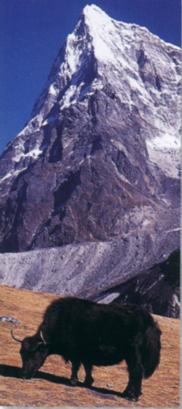

Genus: Bos
Species: grunniens

Most domestic yaks of Tibet, and central Asia have black-brown, dense, woolly, and extremely shaggy coats. The wild yak of the Tibetan Plateau has a black-brown coat with patches of white. They have horns that grow up to 20 inches long in females, and 40 inches in males. The curved horns grow out from the sides of their heads and curve upwards. They use their horns to dig under the snow for food. Their bodies can grow up to 11 feet in length, their tails can grow up to 24 inches and are very bushy. The males' weight is usually 670-1,210 pounds. The females weigh about a third as much.
Yaks are wild undomesticated ox who live in Tibet and central Asia. The wild yak has adapted to living in harsh and barren areas of the Himalayan alpine region. They are one of the few animals that live at these high altitudes. Their coats have long outer hair and dense underfur to keep in their body heat. Even their digestive tract helps keep them warm. Food in the rumen ferments at 104°F, acting like an internal furnace. Their hooves are formed from two enlargedtoes and spread the yak's weight in deep snow and gives them a good grip on bare and rocky slopes.
They inhabit areas where there are lots of lichens, grasses, and tubers. The yak's stomach can't digest grains, so herdsman have to keep moving their domestic herds to fresh pastures.
Most of the year yak travel in single sex herds. A herd can consist of 20 to 200 animals. In the fall a bull will join a herd of females and stay with them through their breeding season. The cow will be pregnant for about eight months and give birth to one calf every other year. Their babies are born around June. Female calves stay with the herd, but the bulls move away after three years to join a bachelor herd. Their average life span is about 23 years.
They spend their summers on the high plateaus above the snow line to get away from the heat. Wild yak can easily live in temperatures of -40° F because of their dense coats, but will move to the lower plains before the freezing winter weather arives.
Yaks help to prevent grasslands from growing too tall by eating the grasses. They move around so they don't overgraze any area. Their dried dung is used as fuel, which is very important in the treeless regions where they live.
There are over 12 million yak in the world; most of them are domestic. The wild yak was domesticated about 2,000 years ago. Unfortunately, the number of wild yak is decreasing very quickly, due to uncontrolled hunting, and by their pastures being taken over by domestic yak. There are probably only a few hundred wild yak, and they have been categorized by the IUCN as endangered. Wild yak are now officially protected in China.
2001
Bibliography:
Huffman, Brent. "yak.", http://www.ultimiteungulate.com/yak.html, (2 June 2000).
"Yak.", Compton's Encyclopedia. 1992ed.
"Yak", Wildlife Explorer. USA: International Masters Publishers. 1998.